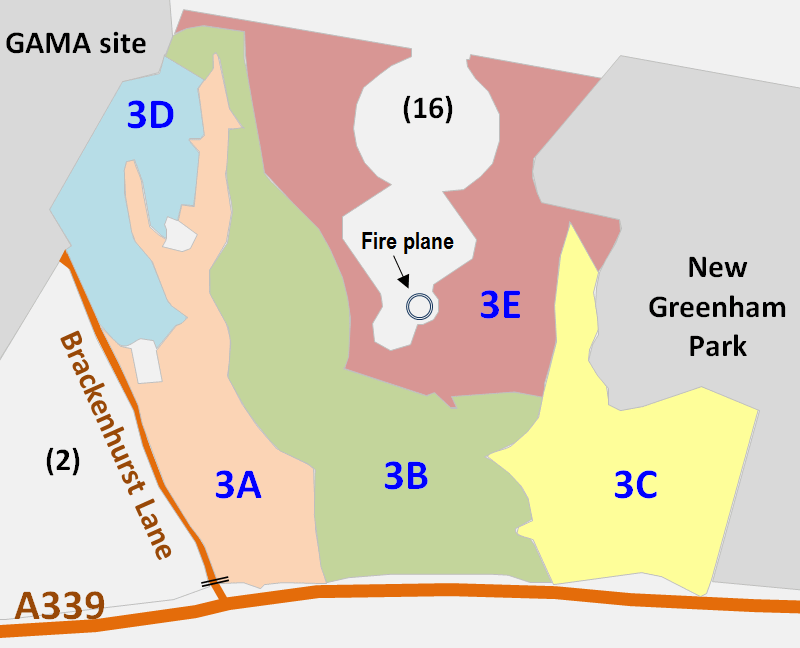
Compartment 3 covers the area between Brackenhurst Lane and the GAMA site to the west, and New Greenham Park to the East. The compartment borders the A339 to the south, and its northern boundary is the old southern taxiway. However it excludes the gravel area (part of Compartment 16) that marks the site of an old aircraft turning pan and the area around the fire plane. This is a relatively large compartment totalling 40.78 hectares split into 5 subcompartments. 3A is Aldernbridge Gully, 3B is Aldernbridge (or Ballshill) Heath and 3C includes Handpost Gully, Ballshill Gully and Peaked Hill.
The compartment is a microcosm of the whole site with areas of wet woodland, ponds, bare gravel, scrub, wood pasture, secondary woodland, dry heath and acid grassland. The whole area (with the exception of a number of exclosures set up for botanical monitoring in the valley bottoms) is available for grazing by cattle and Exmoor ponies.
General description and evaluation of ecology
The compartment is varied and contains extensive areas of wet woodland associated with natural seepages, extant ponds and drainage features from the old airfield (3B and 3C). Tall out-grown alder coppice dominates the three main gullies (Ballshill, Handpost and Aldernbridge), which are very deeply incised in places. Willow carr is present in places at the valley heads but generally alder grades to birch, oak (some of it akin to wood pasture) and other species (including some individual rowan) on the higher slopes. There is possible evidence of old woodbanks in places. Ground flora is rich, particularly in the flushes which have a good range of bryophytes (including a number of Sphagnum mosses) and vascular plants such as opposite-leaved golden saxifrage. 3B has areas of open dry heath with acid and neutral grassland, scrub, bracken, mixed woodland, an important wet flush and a series of ephemeral ponds known to support a good population of great crested newts. A number of slopes with a southerly orientation provide good areas for reptiles and invertebrates. There is an artificial fenced pond at the head of Aldernbridge Gully which is of interest. Scots pine, birch, sycamore and holly grade into scrub, bracken and some pioneer communities in subcompartment 3D with an area of scrub, grassland and bare gravels at 3E, particularly suitable for woodlark and nightjar.
BAP habitats
- Lowland heathland (3B, 3E)
- Ponds (3B)
- Wet woodland (3A, 3C)
Higher Level Stewardship
Overall management objectives
The areas of wet woodland, almost exclusively alder, and the existing structure of the woodland - typified by tall mature mainly single-stemmed individuals with a ground layer rich in bryophytes - will be maintained as such with minimal intervention. Wet species-rich flushes will be safeguarded, if necessary removing some scrub where there is evidence that these are drying out. The drier woodland on the upper slopes and higher ground will be retained favouring oak over birch where this is akin to wood pasture. Other individual trees including rowan, holly and veteran birch specimens will be retained.
Areas of wet and dry heath will be retained and where possible extended by scalloping the edges of adjacent secondary woodland and removing a proportion of scrub. Scrub, predominantly birch, will be maintained along the woodland and heathland edge and cut in small sections to provide an important cover and wood/heath edge habitat. The ephemeral ponds will be retained, enhanced and added to, creating a greater network. The wide screen of woodland alongside the A339 will be maintained.
There will be some selective felling of Scots pine, sycamore and birch to benefit ground flora and to extend areas of heath but many large mature trees will be retained as fungal hosts and to benefit birds and invertebrates.
Gorse scrub will largely be retained but managed by coppicing to provide a varied age structure. Thickets of bramble will be retained where possible to provide habitat for reptiles, small mammals and birds.
The mosaic of bare gravels, open grassland and scrub will be managed to favour ground-nesting birds including woodlark, nightjar, lapwing and little ringed plover.
Subcompartment 3A (7.6 ha) Aldernbridge Gully
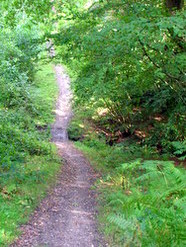
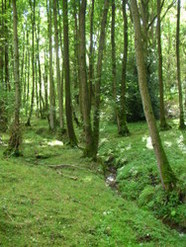
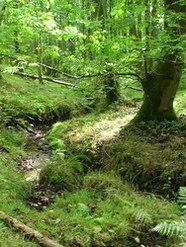
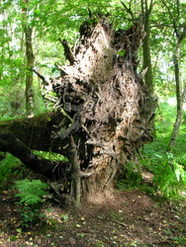
The area known as Aldernbridge Gully is characterised by wet woodland - exclusively tall, out-grown alder coppice on the valley floor and lower slopes fed by springs, seepages and the former airfield settling pond (in subcompartment 3B) at the head of the valley. There are two small tributary streams. Woodland on the higher slopes is predominantly oak (akin to wood pasture) and birch with some willow carr and wet birch at the valley head. The ground flora is rich on the valley floor, markedly so around the springs and seepages with a range of bryophytes (including some Sphagnum mosses) and vascular plants including opposite-leaved golden saxifrage. The water is extremely iron-rich, this is more prominent towards the head of the valley and may originate from water seeping through metal debris left over from the airfield. There are some old open-growth hawthorns on drier slopes in this compartment and some evidence of woodbanks.
| Objective | Area | Method | Comment |
|---|---|---|---|
| 3A.1) Maintain as high forest. | Alder woodland on valley floor and lower slopes. | Minimal intervention in the woodland to allow it to move towards ‘high forest’. | Subject to review of alder management in all the gullies across the common. To include the incorporation of objectives set out in Bryophyte and Lichen Site Dossier (NatureBureau 2009). |
| 3A.2) Investigate water source and quality. | Head of valley. | Seek advice from Environment Agency. | Pronounced iron enrichment. |
| 3A.3) Maintain woodland screen alongside A339. | Wide, mainly birch woodland screen in SW corner. | Minimal intervention. | |
| 3A.4) Maintain exclosures in valley bottom. | Across gully just upstream of confluence. | Repair damaged parts. | To be used in alder gully monitoring highlighted in surveys. |
Subcompartment 3B (11.9 ha) Aldernbridge/Ballshill Heath
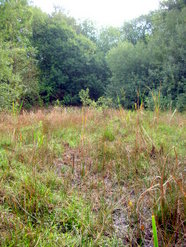


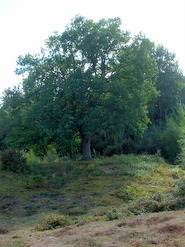
Known as Ballshill Heath this is a diverse area incorporating dry heath, acid grassland with bracken and an important wet flush. There are areas of scrub (gorse and birch) and secondary birch woodland with some older mixed woodland, with a large proportion of oak. There is also a small clump of suckering aspen. A fenced concrete-lined balancing pond from the days of the airbase lies at the northern end of this sub-compartment, and old gravel winning pits have formed a series of ephemeral ponds, important strongholds for great crested newts. The undulating topography at the southern end is of importance, not least for the series of south-facing slopes which provide basking areas for reptiles and a warm microclimate for invertebrates.
| Objective | Area | Method | Comment |
|---|---|---|---|
3B.1) Maintain extent of dry heath and acid grassland. Increase areas where possible.
HLS Objectives |
Aldernbridge Heath. | Graze extensively. Control bracken using a combination of cutting by hand or rolling in spring to bruise stems and weaken rhizomes, followed by application of fern-specific herbicide. Remove selected birch scrub and treat stumps where good patches of heather persist under canopy. Retain single trees and clumps/thickets of birch scrub and bramble across the open heath to provide cover and structural diversity. Consider weed-wiping. Retain a birch scrub edge on woodland and heath margins. Retain concrete and other rubble as hibernacula and basking areas in NE corner of compartment. Retain and enhance log and brash habitat piles for amphibians around ponds and across subcompartment. |
|
| 3B.2) Maintain woodland screen alongside A339. | Wide, mainly birch woodland screen in SW corner. | Non-intervention. Retain any standing or fallen dead wood. | |
| 3B.3) Open up and repair settling pond. | Head of feeder stream into Aldernbrige Gully. | Cut and remove encroaching scrub to prevent pond from drying out. Coppice selected individual stems of alder. Focus on the south side. Dig up and remove 1/3 of reedmace each year. Investigate and repair seepage to retain water for longer into the summer. |
Maintain a screen to general public. |
| 3B.4) Maintain and extend pond complex. | Newt ponds. | Maintain openness of ponds by removing willow and other encroaching scrub, particularly on southern edges. Monitor and if necessary limit dominance of reedmace. | Further ponds and their management will be identified in the Ponds Management Plan. |
| 3B.5) Increase area of acid grassland/heathland by 2015. | SE corner, woodland edge. | Scallop edges of birch woodland to free acid grassland/heath from canopy cover and remove selected birch, treat stumps. |
Subcompartment 3C (7.3 ha) Ballshill Gully, Handpost Gully & Peaked Hill
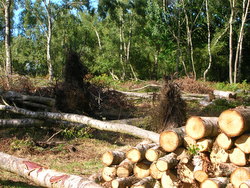
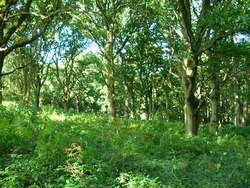
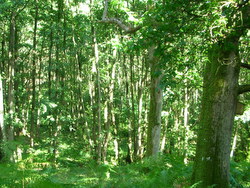
The area known as Ballshill Gully and Handpost Gully is characterised by wet woodland. This rises to drier elevated land at Peaked Hill which separates these two small valleys and up to higher ground to the west and east. Similar in appearance and composition to Aldernbridge Gully to the west (3A) the valley floors have tall alder coppice with a wide selection of bryophytes and typical wet woodland ground flora. However, Handpost Gully in particular is much more steep sided and ravine-like with pools and riffles clearly evident. Further up the valley slopes there are some good individual rowans and holly while at the top of the slope there is a distinct change to birch with elements of oak wood pasture as in 3A, particularly evident in the west of the sub-compartment. There are areas of bracken on the upper slopes to the east and west of the subcompartment and willow carr at the head of the valley.
| Objective | Area | Method | Comment |
|---|---|---|---|
| 3C.1) Maintain wet woodland as high forest. | Alder woodland on valley floor and lower slopes. | Minimal intervention in the woodland to allow it to move towards ‘high forest’. Retain any standing and fallen dead wood as habitat for invertebrates, fungi, bryophytes and vascular plants. Retain individual rowan and holly on east side of Handpost Gully upper slopes. |
Subject to review of alder management in all the gullies across the common. To include the incorporation of objectives set out in Bryophyte and Lichen Site Dossier (NatureBureau 2009). |
| 3C.2) Maintain and enhance where possible the oak ‘wood-pasture’. | Oak and birch area on higher slopes of valley. | Graze extensively. Fell and stump-treat, or ring bark selected birch where these are to the detriment of the oak wood pasture. Retain any standing or fallen dead wood. Promote oak regeneration by planting,and protect saplings from grazing. |
Collection and propagation of acorns or oak seedlings from the common would provide a suitable source. |
| 3C.3) Diversify structure of willow carr and maintain extent. | Head of valley NW corner of subcompartment. | Coppice selected willows occasionally on a 10 year rotation (<50% total in this period) to maintain carr habitat, reduce potential drying out and maintain good cover. | |
| 3C.4) Maintain woodland screen alongside A339. | Woodland screen in SW corner. | Non-intervention. Retain any standing or fallen dead wood. | |
| 3C.5) Maintain exclosures in valley bottom. | Either side of gully towards southern end. | Repair damaged parts. | To be used in alder gully monitoring highlighted in surveys. |
Subcompartment 3D (3.8 ha)
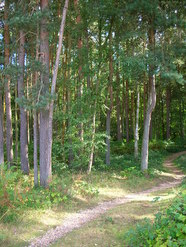
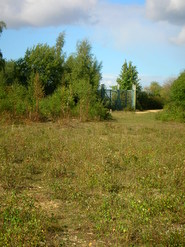
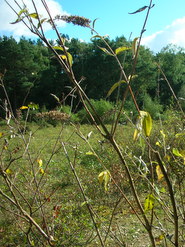
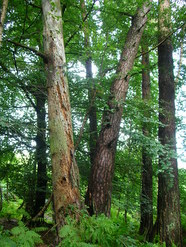
This subcompartment is predominantly wooded and includes areas of mature Scots pine, birch, sycamore and holly. There is some younger birch scrub over relict heathland and other scrub components elsewhere including gorse, blackthorn and willow. An area of gravel occupies the position of a former fuel depot at the northern end of the subcompartment. This has been colonised by a range of pioneer grassland species and vigorous scrub including buddleia and willow.
| Objective | Area | Method | Comment |
|---|---|---|---|
| 3D.1) Maintain area of heathland/grassland at 2012 extent. | Former fuel depot and surroundings. | Graze extensively. Fell birch and remove scrub where it shades existing heather and grasses, treat stumps. Spread forage-harvested cuttings of heather from elsewhere on site on a small trial are of bare gravels adjacent to this area. Where necessary scrape or scarify using a digger bucket/grading bar/attachment to retain areas of bare gravel and reset succession within this mosaic. Retain a scrub screen alongside the path. |
|
| 3D.2) Reduce buddleia, willow and gorse to 50% of 2012 extent by 2015. | Former fuel depot site (open gravel area). | Cut and treat stumps, or weed-wipe. | Retain structural graduation into woodland edges. |
| 3D.3) Increase and retain woodland structural diversity by 2015. | Mixed plantation south of former fuel depot (open gravel area). | Identify good mature pines and thin selected trees around them and/or widen ride to benefit ground flora and invertebrates. Retain stand of mature birch immediately to north of Brackenhurst Lane property. |
|
| 3D.4) Control erosion by mountain bikes. | Steep paths through woodland. | Positively reinforce suitable routes by selective felling of trees and scrub. |
Subcompartment 3E (10.2 ha)
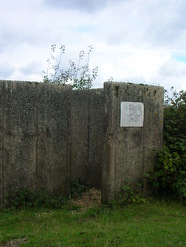


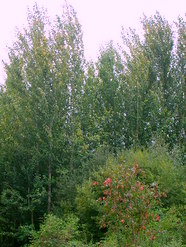
This is the area to the south of the southern taxiway near the fire plane and surrounding an old turning pan at the edge of the former airfield. Characterised by a series of structures from airfield days it includes a variety of disturbed and early successional habitats. There are patches of birch and bramble scrub, bare gravels, heathland and species-poor grassland. This area and the adjacent part of compartment 16 are of significance for nightjar, woodlark, little ringed plover, ringed plover, lapwing, meadow pipit plus a number of other bird species including linnet and nightingale. One of the old buildings has been modified for use as a summer bat roost.
| Objective | Area | Method | Comment |
|---|---|---|---|
3E.1) Maintain area of heathland and dry acid grassland. Extend areas where possible.
HLS Objectives |
Western edge of subcompartment. | Graze extensively. Fell and clear birch and other species including bramble where these are shading out heather but retain thickets for structural diversity and for species such as nightingale. | |
| 3E.2) Reduce opportunities for crow predation of ground-nesting birds. | Adjacent to compartment 16 south. | Remove tall trees and scrub. | These can be used by crows to watch ground nesting birds. |
| 3E.3) Manage bramble and birch scrub. | Throughout subcompartment. | Graze extensively. Clear a selection (>30% of 2010 cover over the period) of bramble and birch scrub on open grassy and heath areas to benefit grassland/heath and retain structural diversity. Do not treat. | Bramble provides good shelter and nesting opportunities for a range of fauna and a nectar source for invertebrates. |
| 3E.4) Reduce ragwort. | Open grassy area at NW end of subcompartment. | Spray with glyphosate (Roundup) or Barrier H at rosette stage and/or pull by hand and remove before it sets seed (annually). | Ragwort seed from here blows across the site and onto the neighbouring business park. |
| 3E.5) Maintain extent of gorse cover, and diversify structure by 2015. | NE corner of sub-compartment, adjacent to Business Park. | Cut bays into eastern and/or northeastern edges of gorse by hand or with chainsaw to provide shelter on leeward side and increase structural diversity. Maintain bays by coppicing. | |
| 3E.6) Retain and create bare gravel areas. | Adjacent to Compartment 16 south. | Scrape using digger bucket/grading bar/attachment to remove any soil and get down to gravels either in discrete patches of early successional stage vegetation or circumscribing Compartment 16 to a width of 5m. Pile arings nearby to enhance relief and extend bare areas. | Important ground nesting bird breeding and foraging area. |